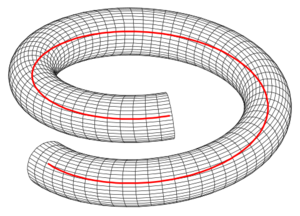Channel surface

In geometry and topology, a channel or canal surface is a surface formed as the envelope of a family of spheres whose centers lie on a space curve, its directrix. If the radii of the generating spheres are constant, the canal surface is called a pipe surface. Simple examples are:
- right circular cylinder (pipe surface, directrix is a line, the axis of the cylinder)
- torus (pipe surface, directrix is a circle),
- right circular cone (canal surface, directrix is a line (the axis), radii of the spheres not constant),
- surface of revolution (canal surface, directrix is a line),
Canal surfaces play an essential role in descriptive geometry, because in case of an orthographic projection its contour curve can be drawn as the envelope of circles.
- In technical area canal surfaces can be used for blending surfaces smoothly.
Envelope of a pencil of implicit surfaces
Given the pencil of implicit surfaces
- [math]\displaystyle{ \Phi_c: f({\mathbf x},c)=0 , c\in [c_1,c_2] }[/math],
two neighboring surfaces [math]\displaystyle{ \Phi_c }[/math] and [math]\displaystyle{ \Phi_{c+\Delta c} }[/math] intersect in a curve that fulfills the equations
- [math]\displaystyle{ f({\mathbf x},c)=0 }[/math] and [math]\displaystyle{ f({\mathbf x},c+\Delta c)=0 }[/math].
For the limit [math]\displaystyle{ \Delta c \to 0 }[/math] one gets [math]\displaystyle{ f_c({\mathbf x},c)= \lim_{\Delta c \to \ 0} \frac{f({\mathbf x},c)-f({\mathbf x},c+\Delta c)}{\Delta c}=0 }[/math]. The last equation is the reason for the following definition.
- Let [math]\displaystyle{ \Phi_c: f({\mathbf x},c)=0 , c\in [c_1,c_2] }[/math] be a 1-parameter pencil of regular implicit [math]\displaystyle{ C^2 }[/math] surfaces ([math]\displaystyle{ f }[/math] being at least twice continuously differentiable). The surface defined by the two equations
- [math]\displaystyle{ f({\mathbf x},c)=0, \quad f_c({\mathbf x},c)=0 }[/math]
is the envelope of the given pencil of surfaces.[1]
Canal surface
Let [math]\displaystyle{ \Gamma: {\mathbf x}={\mathbf c}(u)=(a(u),b(u),c(u))^\top }[/math] be a regular space curve and [math]\displaystyle{ r(t) }[/math] a [math]\displaystyle{ C^1 }[/math]-function with [math]\displaystyle{ r\gt 0 }[/math] and [math]\displaystyle{ |\dot{r}|\lt \|\dot{\mathbf c}\| }[/math]. The last condition means that the curvature of the curve is less than that of the corresponding sphere. The envelope of the 1-parameter pencil of spheres
- [math]\displaystyle{ f({\mathbf x};u):= \big\|{\mathbf x}-{\mathbf c}(u)\big\|^2-r^2(u)=0 }[/math]
is called a canal surface and [math]\displaystyle{ \Gamma }[/math] its directrix. If the radii are constant, it is called a pipe surface.
Parametric representation of a canal surface
The envelope condition
- [math]\displaystyle{ f_u({\mathbf x},u)= 2\Big(-\big({\mathbf x}-{\mathbf c}(u)\big)^\top\dot{\mathbf c}(u)-r(u)\dot{r}(u)\Big)=0 }[/math]
of the canal surface above is for any value of [math]\displaystyle{ u }[/math] the equation of a plane, which is orthogonal to the tangent [math]\displaystyle{ \dot{\mathbf c}(u) }[/math] of the directrix. Hence the envelope is a collection of circles. This property is the key for a parametric representation of the canal surface. The center of the circle (for parameter [math]\displaystyle{ u }[/math]) has the distance [math]\displaystyle{ d:=\frac{r\dot{r}}{\|\dot{\mathbf c}\|}\lt r }[/math] (see condition above) from the center of the corresponding sphere and its radius is [math]\displaystyle{ \sqrt{r^2-d^2} }[/math]. Hence
- [math]\displaystyle{ {\mathbf x}={\mathbf x}(u,v):= {\mathbf c}(u)-\frac{r(u)\dot{r}(u)}{\|\dot{\mathbf c}(u)\|^2}\dot{\mathbf c}(u) +r(u)\sqrt{1-\frac{\dot{r}(u)^2}{\|\dot{\mathbf c}(u)\|^2}} \big({\mathbf e}_1(u)\cos(v)+ {\mathbf e}_2(u)\sin(v)\big), }[/math]
where the vectors [math]\displaystyle{ {\mathbf e}_1,{\mathbf e}_2 }[/math] and the tangent vector [math]\displaystyle{ \dot{\mathbf c}/\|\dot{\mathbf c}\| }[/math] form an orthonormal basis, is a parametric representation of the canal surface.[2]
For [math]\displaystyle{ \dot{r}=0 }[/math] one gets the parametric representation of a pipe surface:
- [math]\displaystyle{ {\mathbf x}={\mathbf x}(u,v):= {\mathbf c}(u)+r\big({\mathbf e}_1(u)\cos(v)+ {\mathbf e}_2(u)\sin(v)\big). }[/math]
Examples
- a) The first picture shows a canal surface with
- the helix [math]\displaystyle{ (\cos(u),\sin(u), 0.25u), u\in[0,4] }[/math] as directrix and
- the radius function [math]\displaystyle{ r(u):= 0.2+0.8u/2\pi }[/math].
- The choice for [math]\displaystyle{ {\mathbf e}_1,{\mathbf e}_2 }[/math] is the following:
- [math]\displaystyle{ {\mathbf e}_1:=(\dot{b},-\dot{a},0)/\|\cdots\|,\ {\mathbf e}_2:= ({\mathbf e}_1\times \dot{\mathbf c})/\|\cdots\| }[/math].
- b) For the second picture the radius is constant:[math]\displaystyle{ r(u):= 0.2 }[/math], i. e. the canal surface is a pipe surface.
- c) For the 3. picture the pipe surface b) has parameter [math]\displaystyle{ u\in[0,7.5] }[/math].
- d) The 4. picture shows a pipe knot. Its directrix is a curve on a torus
- e) The 5. picture shows a Dupin cyclide (canal surface).
References
- Hilbert, David; Cohn-Vossen, Stephan (1952). Geometry and the Imagination (2nd ed.). Chelsea. p. 219. ISBN 0-8284-1087-9. https://archive.org/details/geometryimaginat00davi_0.
External links
 |





